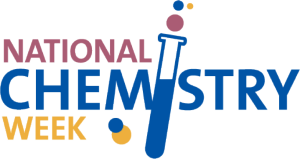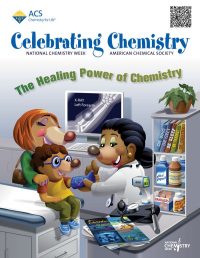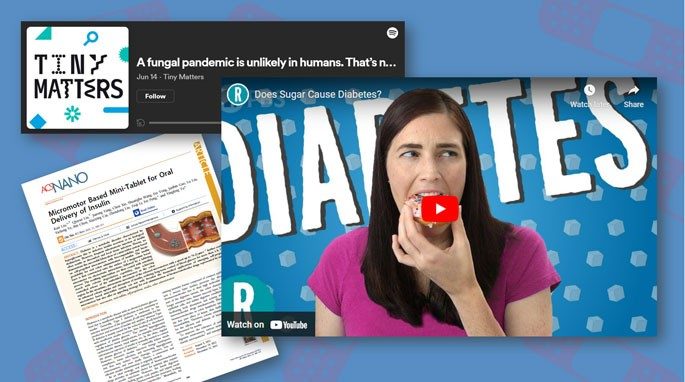Educational Resources
NCW 2023 The Healing Power of Chemistry
Find educational resources for this year's National Chemistry Week theme and other materials for your event, including outreach activities, articles, and videos.
Explore and understand how chemistry plays an essential role in healing. Learn more about how the body heals itself, how nature has provided us with medicines, how milk of magnesia works in your stomach, and much more!

Hands-on Activity: Cloudy with a Chance of Clear Color
Mix a medicine called milk of magnesia with red cabbage juice and vinegar, rather than your own stomach acid, for some surprising color changes. Find the activity in the latest issue of Celebrating Chemistry.
Elementary & Middle School (Ages 5-13)
From Adventures in Chemistry (Grades K-5)
- The Fate of Calcium Carbonate
- Add vinegar to an antacid tablet and an eggshell to find out what they have in common.
- Warm up to Some Cool Reactions
Practice reading a thermometer as you check out two temperature-changing chemical reactions. - The Secret Science of Braces
Read about the science of braces, toothpaste, and filling cavities.
From Inquiry in Action
- Designing an Absorbency Test
Test to see which of 4 materials absorbs water. View an animation that shows how water molecules are attracted to paper and felt and move up through spaces in the material.
From Middle School Chemistry
- The Ups and Downs of Thermometers
Do a hands-on activity and view molecular model animations to discover how thermometers work. - Temperature Changes in Dissolving
Use a thermometer while dissolving a few different household substances in water to explore the inner workings of instant hot and cold packs. Then, view animations to see how the breaking and making of bonds during dissolving causes these temperature changes. - Neutralizing Acids and Bases
Explore the color changes that result when citric acid and sodium carbonate are added to universal indicator solution. View animations to find out how acids and bases neutralize each other.
High School (Ages 14-18)
From AACT
- Activity: Designing an Effective Respiratory Cloth Mask
- Activity: Nuclear Medicine Half Lives
- Activity: Case Study - The Lung Cancer Mystery
- Activity: Herbal Remedies
- Lab: Soap or Fuel
- Lab: Over the Counter Drugs
- Lab: Aspirin Tablets - Are They all the Same?
- Lab: The Chemistry of Hand Sanitizer and Soap
- Lesson Plan: The Vitamin B Complex
- Lesson Plan: The Chemistry of Vaccines
- Lesson Plan: Discovery of Ivermectin: Preventing Blindness and Heartworm
- Lesson Plan: Chocolate: The New Health Food
- Project: Discovering Chemical Elements in Food
From ChemMatters Magazine
- Could Vaccines be Pain Free
- The Opioid Epidemic: How Did It Get This Bad?
- What is Hand Sanitizer, and Does It Keep Your Hands Germ Free?
- Pathway to Pain Relief
- Brush Up on Toothpaste
- Got Vitamin D?
- Clearing the Way to Acne-Free Days
- Drugs Down the Drain -The Drugs You Swallow, the Water You Drunk
- Nanotechnology's Big Impact
More Resources for Educators
- Celebrating Chemistry
Celebrating Chemistry is a publication designed to engage and educate children (grades 4-6) in the basic principles of chemistry and is available in both English and Spanish. - Meg A. Mole Career Profiles
Read all about Meg's many adventures! These interviews are an excellent resource for teachers to inform their students about the activities chemists perform every day. Need to explain a mole? Check out our “Meet the Moles!” web page. - ChemMatters
ChemMatters is a magazine that helps high school students find connections between chemistry and the world around them. Check out our article on Laura Hoch, a material innovation chemist for Patagonia.
- Journal of Chemical Education
A journal for chemical educators featuring activities and articles. - Science Safety Guidelines
Consult the Science Safety Guidelines to incorporate safe practices into your teaching curriculum. - National Historic Chemical Landmarks
Learn about special places in chemical history, and download lesson plans for engaging classrooms. Check out the following Chemical Landmarks: Wallace Carothers and the Development of Nylon, Cotton Products Research: Durable Press and Flame Retardant Cotton, Development of Tide Synthetic Detergent



